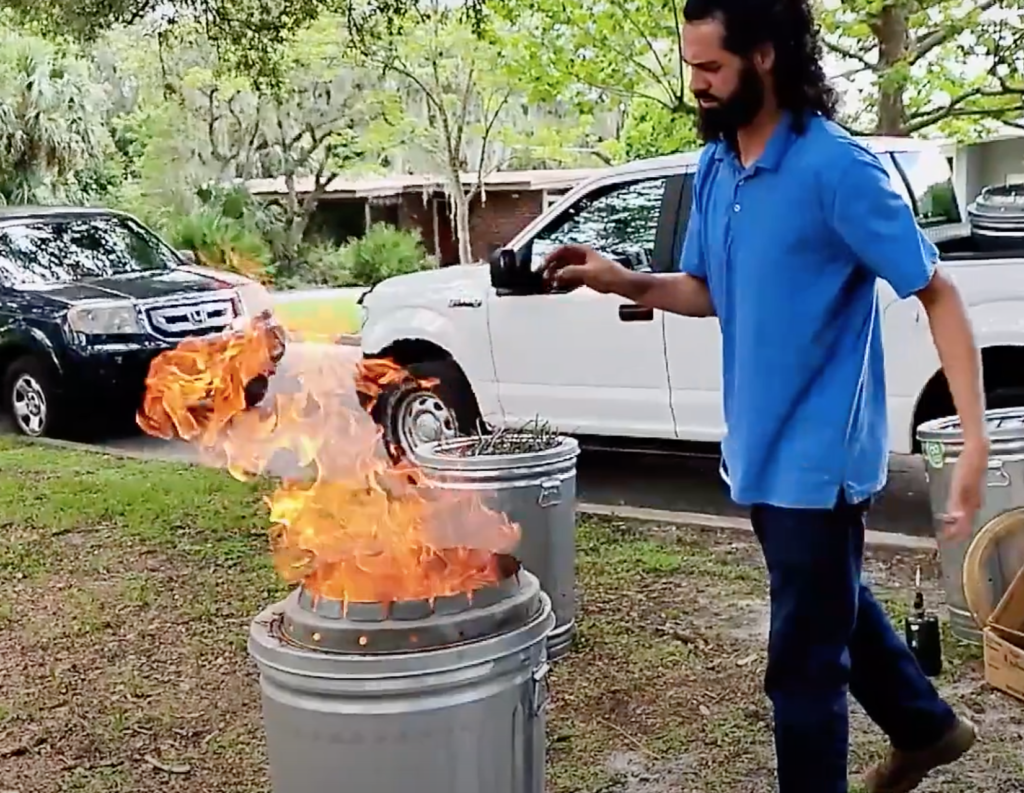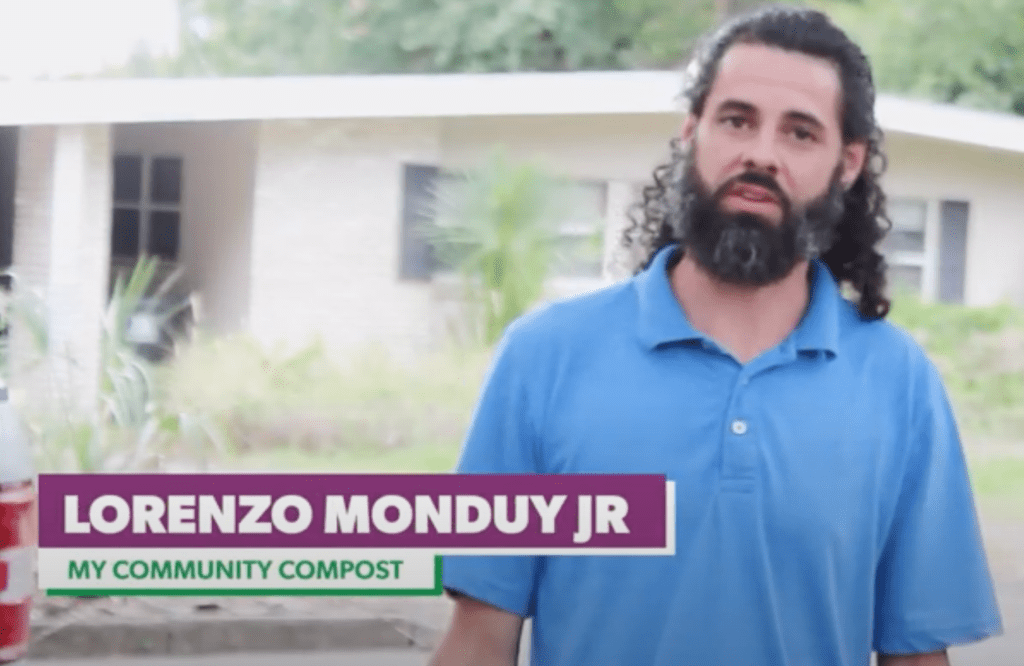Do you have compost in your backyard and want to make it even more rich and fertile? The IDEAS Hive interviewed Lorenzo Monduy Jr, the designer and face behind My Community Compost to talk about biochar, composting, and his Gasifier invention.
What is biochar?

Monduy describes biochar, or black carbon, as an “Electrocarbon sponge to manage carbon across the planet and increase soil fertility.” Put simply, it is the burnt material (similar looking to charcoal) of organic matter in a controlled process. When mixed in with soil or compost, biochar holds on to nutrients, water, and microorganisms, making it easier for these things to be exchanged in the soil. The University of Florida describes it as “When applied as soil amendments, biochars are known to improve soil physical and chemical properties, such as increasing soil fertility and productivity.” (1)
What is the Gasifier?
It’s an easy way to turn yard waste into biochar at home. The Gasifier is a way to help the average person make biochar at home or on the farm, turning yard debris into biochar with a safe and fast design. Carbon has four valence electrons and can attach to all sorts of things. It is the backbone and building block of life. In the Gasifier, almost everything of the organic material is stripped away except for carbon.
Most importantly, the Gasifier retains the shape of the plan. Much of our soil in Florida gets superheated by the sun and tends to ionize and repel water. When we increase the cation exchange capacity of the soil, the soils is able to retain water and nutrients better. We want to increase surface area as much as possible. To do this, it is best for the biochar to be a fine particle size, ideally smaller than a grain of rice. Even at that size, it has a tremendous surface area.
Basic Biochar Step-by-Step:

- Collect Your Burning material:
- Yard Clippings, Bamboo, Wood, Pine Straw, Hay
- Burn The Materials in Your Gasifier Until Flame is Gone
- Cool with Water Before Drying
- Crush as Small as Possible
- “Charge” with Nutrients:
- Compost, Nutrient Tea, or Add Directly Into Soil
Using the Gasifier:
- You will want to fill them as dense as possible with limbs placed vertically. At the top, be sure no material past the holes. Stack as densely as you can and then get a finer material on top, like twigs or pine needles (pine needles are great for starting the fire!).
- When it is completely full of organic material, it will burn down to ⅓ in size (full of biochar). Because of this, you can keep adding material as it burns. The Gasifier slows down the process of burning in order to maximize the amount of biochar burning.
- Bamboo is probably the best material to use because of the tube structure. The tube like-structure is easiest for microorganisms, nutrients, and ions to travel across.
- Use a lighter to light on fire and it should take off from there.
- It will be a smokeless burn for most of it. You’ll know it is done burning when the flames are gone and it will be left with glowing red embers.
- If you were to fill it tightly, the material will burn for an hour at least. You can keep adding to the Gasifier and burn all day until the whole thing fills with biochar.
- With protective gloves, tip the container and pour all the embers in a water trough or bucket, spray it down with water, or pour a bucket of water into the Gasifier itself.
- If placing a lid on top, it will cool everything but there will still be some air coming in, so putting the biochar out with water is the best idea. Give it a little mix to make sure there isn’t anything still needing to be burnt inside the Gasifier.
- Putting the biochar into a container is better is because pouring water into the Gasifier will reduce the longevity of it. Older models lasted 50 burns, and Monduy expects the new model to last longer as holes are smaller.
- Optional – cook on top! Set a grill plate while the fire is going and cook veggies, meat, or whatever else you want to grill.
Troubleshooting:
See smoke? It isn’t yet hot enough, or there isn’t enough airflow. If the organic material is packed in very densely, create a hole or channel in the center, in order to get airflow going.
If there is a lot of material within the biochar, it will be difficult to get hot enough to keep the chain reaction going. As it lights on fire, the fire creates an updraft that sucks in air in the holes of the Gasifier. This creates a vacuum and causes the gases being released while burning to be sucked down into the inner chamber of the Gasifier, to come out near the top. The holes at the top help mix the air, creating a zone of combustion called pyrolysis zone. Here, oxygen is limited, and that air moves from top-down, making everything carbonized. This is why it burns with no smoke.
Once it is all done and burnt to the bottom, you can keep adding to it, and can fill the whole thing up with char in a day or less. If you keep feeding it and keep making char, mix it a bit to make sure all the pieces are burnt off. You’ll know it is all burnt off when there are no flames. If you do put more material, keep in mind the diameter and density of the material. It will keep more twigs burnt up. Otherwise, you will burn the actual biochar. So, if you are adding big stuff, add smaller stuff too.
Mixing Biochar with Compost:
- Turn your compost pile with bichar present every other day for 18 days, a total of 8 turns, and you end up adding all that biochar.
- Let sit 2-3 months, slowly becoming a very rich biochar compost.
- After sifting, it is an ideal seed starting mix.
About Lorenzo Monduy Jr.

Lorenzo Monduy Jr, the Gasifier designer and person behind My Community Compost? He began making biochar in 2019 but has been interested in building since 2011. A combat veteran from the Iraq war who invested in gold and silver while there, he lost a lot of money in the stock market in 2008, so he started to take classes on how to find gold. He took geology classes and found soil a lot more interesting than gold. He soon began to learn more about waste transformation and water purification. After buying land in Ocala, he began investing in land and learned how to grow his own food, with the goal to be sustainable. Initially interested in aquaponics, he decided to reach out to his community and found a local source of mulch.
After connecting with someone leading a community composting program in St. Augustine, he took a class on composting. Eventually, he developed his own composting program, My Community Compost. He began going from a 25-mile radius around him collecting food waste from restaurants within the community. Combined with the mulch, he created a compost. He stumbled upon biochar after a friend sent a documentary about past civilizations, in the middle of the documentary there was a quick excerpt from the Amazon rainforest where indignous people were making Terra Preta, dark rich soil “of the Amazon Basin [and] are one of the more widely known examples of biochar.” (1) He began to join biochar groups on Facebook and other online forums, and began to make some bichar himself.
After adding it to his compost and seeing a lot of improvement, he touched base with someone from the University of Florida who had once mentioned biochar to him. From then, Monduy says it began to feel like the “one thing I can focus on and make a big difference because everyone can do it.”
What are his future plans? He wants to consult and link up with other organizations that have the same mindset of bringing permaculture to communities, and to build stronger and more resilient food safety. Mounday believes that empowering communities and having them be more resilient is the true fight for freedom.
To get your own Gasifier to make nutrient-rich biochar from your yard waste, check out his website, and start burning!
Sources:
(1) https://edis.ifas.ufl.edu/ss585
https://aquaponics.com/aquaponics-in-schools/aquaponics-information/
Feature photo by Markus Spiske on Unsplash








